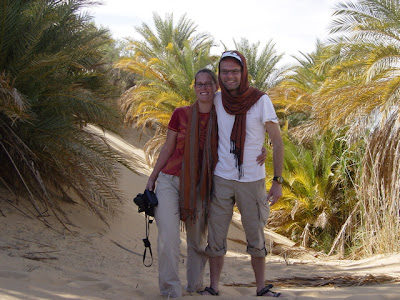 The mountains around Mons Claudianus on Google Earth. The red line in the bottom right is the Safaga to Qena road. The line from the bottom right to the upper left is our off road track to Mons Claudianus.
The mountains around Mons Claudianus on Google Earth. The red line in the bottom right is the Safaga to Qena road. The line from the bottom right to the upper left is our off road track to Mons Claudianus.We drove off with the convoy and we left the road after about 40 km. At a small roadside cafe we picked up a local guide to show us the way. It was not that easy to find, so we were glad we had our guide.
At the side, there was a fortress and the desert floor was full off broken pottery and pieces of quarried granite. You still could see many pieces with the original holes for the wooden wedges. Romans and Egyptian used a technique where they would hammer wooden wedges in a row of small holes they cut in the rock. By poring water on the wedges the wood would expand and break the rock. We had seen similar holes at the quarry of the broken Obelisk in Aswan.
The landscape here is beautiful, but very remote and desolate. Roman prisoners were used to hack the granite out of the mountains and it was a hardship post for the Roman soldiers who guarded them. The enormous granite blocks and pillars quarried here were transported over 180 km of desert and mountains to Qena, where they were put on boats and shipped to Rome and other places. The walls of the fortress and houses of the complex were made up of irregular pieces of granite that where probably not good enough to be shipped to Rome.
A short car drive further we saw an enormous broken pillar, probably left where it was broken 2000 years ago.
Our guide showed us some old water wells where Bedouins were filling up their water tanks, after which he led us back to the main Safaga-Qena road. We dropped him at the cafe and continued our journey to the Nile. We had a tea and lunch break with our police officer at a small roadside cafe just before the checkpoint about half way between Safaga and Qena. When we continued our journey our police officer asked us to drop him off at the checkpoint and we could continue our drive to Luxor alone. We were very happy, but we still do not understand why the convoy is compulsory for foreigners if this police agent let us off so easily. Anyway, we had our freedom back for the rest of the day!
On the way we saw many mini buses with ornamental leaves on their roof rack, sometimes combined with white flags and big loudspeakers. We learned later that these buses were returning pilgrims from the Haj. The pilgrims take the boat back from Jeddah to Safaga, and then continue their journey with buses across the eastern desert. We had never seen this in Cairo around the time of the Haj. Apparently, it is tradition in Upper Egypt to recite Quran verses through the loudspeakers and to carry the leaves and white flags.









1 comment:
Lieve Corine en Jurriaan,
Weer een prachtig verhaal met mooie foto,s en best spannend om zo'n nieuwe route uit te proberen. Want zo lesend leek mij als je vast loopt is er geen weg terug daar is het te stijl voor.
Prachtig de desert fotos en ook weer de reliquen die jullie tegen zijn gekomen.
Liefs ook van Geer, Ppapa / Kees
Post a Comment